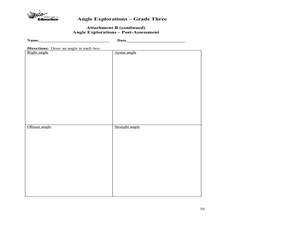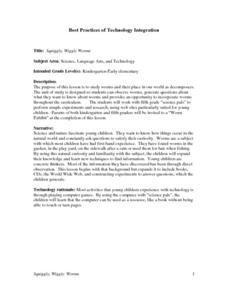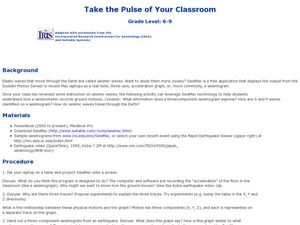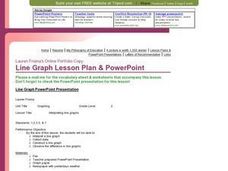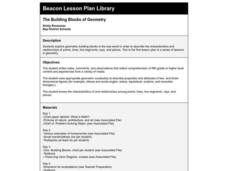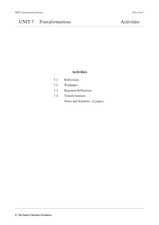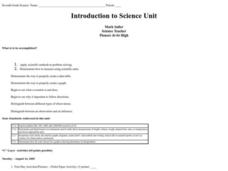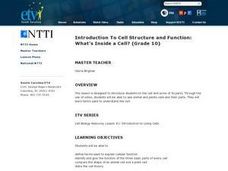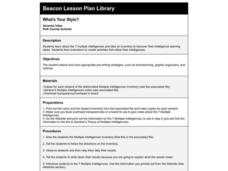Curated OER
Angle Explorations
Third graders observe angles in their classroom and create an angle finder to represent them.In this angles lesson, 3rd graders classify angles as acute, obtuse, right or straight. Students find the differences and similarities in angles.
Curated OER
Gas Laws and Alka-Seltzer Rockets
Students investigate the Ideal Gas Law. In this three states of matter lesson plan, students create Alka-Seltzer rockets using film canisters. Students record observations and data according to the scientific method and explain the gas...
Curated OER
Squiggly, Wiggly Worms
Students, who are in early elementary grades, pair with fifth grade students to study worms. They observe worms in experiments, create research questions, and complete the research using Internet sites. They participate in a "Worm...
Curated OER
States of Matter and Chemical/Physical Changes Stations
Learners break into four groups, starting at different stations. Each station should take about 10 minutes depending on prior knowledge of the topic. They then rotate when everyone is finished to the next station and discuss answers of...
Curated OER
Take the Pulse of Your Classroom
Students discuss seismic waves. In this science lesson, students investigate the acceleration of the floor in the classroom similar to a seismograph. Students observe a three-component seismogram from an earthquake and determine what it...
Curated OER
Particulate Matter
Seventh graders examine the different types of pollutants. In this environmental science lesson, 7th graders observe particulate matter under a microscope. They explain how these can affect once health when breathed in large quantities...
Curated OER
A Galaxy Up Close
In this Sombrero Galaxy worksheet, students observe infrared images taken by the Spitzer Infrared Telescope and the Hubble Space Telescope. They answer 9 questions about the details of the images such as the radius of the stellar...
Curated OER
Looking At Variables
Students predict and test different variables that would effect sugar cubes dissolving in water. In this dissolving lesson plan, students have 4 petri dishes with 4 different variations of sugar cubes and water. They predict which will...
Curated OER
The Power of Persuasion
Learners explore the power of persuasion. In a classroom setting, students discuss incentives, testimonials and deceptive pricing schemes that are used to influence others. After observing professionally made infomercials, learners...
Curated OER
The Martian and the Car
In this living things activity, students determine 5 things about a car that makes it seem like its a living thing and 5 things that prove it is not a living thing. This activity has 10 short answer questions.
Curated OER
Interpreting Line Graphs
Fifth graders interpret line graphs. In this graphing lesson, 5th graders first begin by reviewing the difference in bar and line graphs and what they are used for. Students practice interpreting the data on various line graphs and using...
Curated OER
The Building Blocks of Geometry
Fifth graders explore geometric building blocks in the real world in order to describe the characteristics and relationships of points, lines, line segments, rays, and planes. This is the first lesson plan in a series of lessons in...
Curated OER
Wolf Fact Cards
Students write a non-chronological report about wolves. They read and discuss wolf fact cards in small groups, complete a KWL chart, observe the teacher model the steps of writing a report, and conduct research and write an original...
Curated OER
Spying on Spiders
Students investigate spiders. In this spiders lesson, students create a habitat for a spider with a jar, twigs, and dirt. Students observe the behavior of the spider and record how they spend their days.
Curated OER
Unit 7 Transformations
In this transformations worksheet, students observe the errors in the reflection of a picture. They determine the number of transformations needed to complete a grid. Students perform reflections according to directions and...
Curated OER
Butterfly Lifecycles
What a great way to present this topic! While a little difficult to follow, this lesson provides great ideas for a second grade lesson involving butterfly lifecycles. Learners make drawings of butterflies, discuss life cycles, and write...
Curated OER
Floating Fishes: Boat Sinking Lab
Cut milk cartons in half to make boats and let investigators attempt to sink them. They add dividing walls and observe what happens if marbles are put into only one of the newly formed compartments. Vocabulary is provided: buoyant force,...
Curated OER
Introduction to Science
Seventh graders investigate scientific methods to solve problems. They demonstrate creating data tables and graphs. They study the role of a scientist and the importance of safety in a science lab. They distinguish between an...
Curated OER
How Powerful is Static Electricity
Learners explore energy by participating in controlled electricity experiment. In this static electricity instructional activity, students identify the different sources that can create energy and how static electricity can be created...
Alabama Learning Exchange
What do Plants Need?
Students plant seeds and watch them sprout. Once growing plants are placed in different conditions and students record data about their growth. They graph the data.
Curated OER
What Should I Recycle?
First graders discuss a plan to minimize waste. In this waste management lesson, 1st graders read "Why Should I Recycle," by Jen Green and create a classroom recycling plan.
Curated OER
Introduction To Cell Structure and Function: What's Inside a Cell?
Tenth graders are introduced to the cell and some of its parts. Through the use of video, 10th graders see animal and plants cells and their parts. They learn terms used to explain the cell.
Curated OER
What Are The Chances
Students calculate the probability of an event occurring. In this probability lesson, students differentiate between independent, dependent or compound events. They find the range of the data.
Curated OER
What's Your Style?
Students examine and discuss the seven multiple intelligences. They take an inventory to identify their own learning styles and design activities that utilize their intelligences.
